Case Study Analysis: Starbucks' International Market Entry Strategies
VerifiedAdded on 2022/08/28
|8
|2879
|34
Case Study
AI Summary
This case study analyzes Starbucks' international business strategies, focusing on its market entry and expansion across various countries. The essay examines the company's use of licensing, acquisition, joint ventures, and wholly-owned subsidiaries, assessing the advantages and disadvantages of each strategy. It explores critical factors influencing these decisions, including cultural, economic, and consumer behavior considerations, as well as the application of the resource-based view theory. The analysis highlights the successes and failures of Starbucks' global ventures, such as its experience in Australia, and provides recommendations for future market entries, emphasizing the importance of understanding local market preferences and tailoring strategies accordingly. The study concludes that the selection of appropriate market entry strategies is crucial for successful international expansion and competitive advantage.
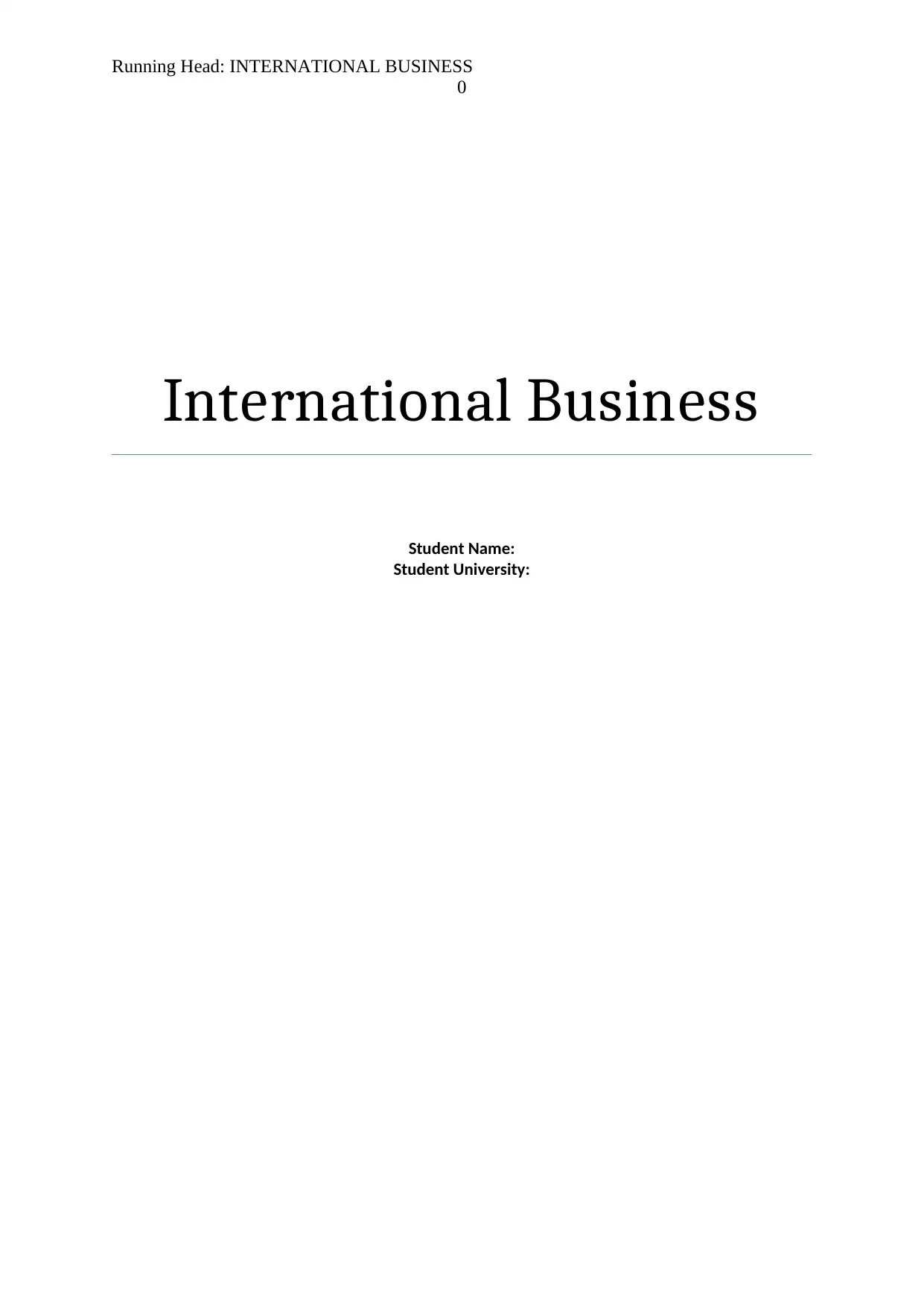
Running Head: INTERNATIONAL BUSINESS
0
International Business
Student Name:
Student University:
0
International Business
Student Name:
Student University:
Paraphrase This Document
Need a fresh take? Get an instant paraphrase of this document with our AI Paraphraser
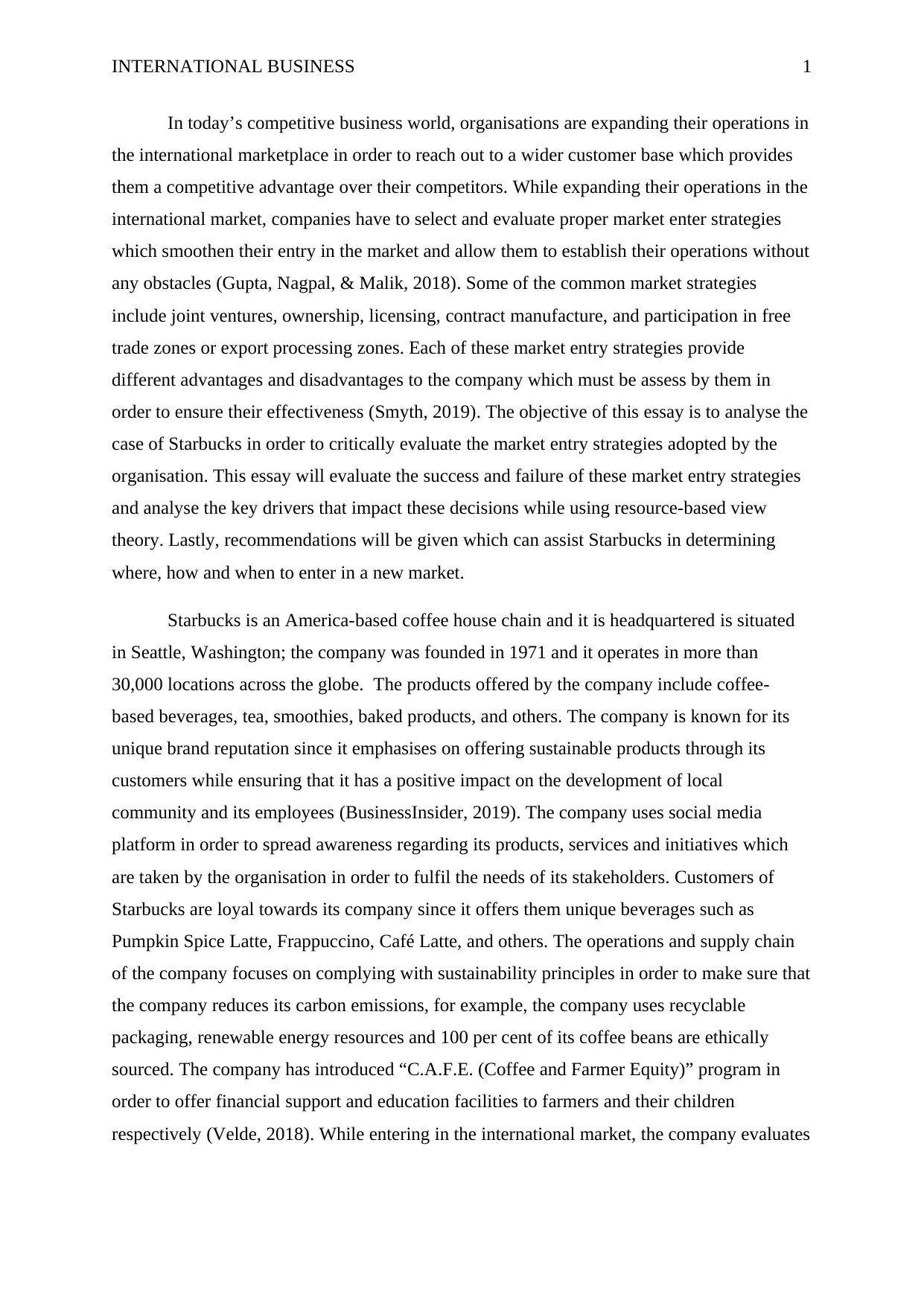
INTERNATIONAL BUSINESS 1
In today’s competitive business world, organisations are expanding their operations in
the international marketplace in order to reach out to a wider customer base which provides
them a competitive advantage over their competitors. While expanding their operations in the
international market, companies have to select and evaluate proper market enter strategies
which smoothen their entry in the market and allow them to establish their operations without
any obstacles (Gupta, Nagpal, & Malik, 2018). Some of the common market strategies
include joint ventures, ownership, licensing, contract manufacture, and participation in free
trade zones or export processing zones. Each of these market entry strategies provide
different advantages and disadvantages to the company which must be assess by them in
order to ensure their effectiveness (Smyth, 2019). The objective of this essay is to analyse the
case of Starbucks in order to critically evaluate the market entry strategies adopted by the
organisation. This essay will evaluate the success and failure of these market entry strategies
and analyse the key drivers that impact these decisions while using resource-based view
theory. Lastly, recommendations will be given which can assist Starbucks in determining
where, how and when to enter in a new market.
Starbucks is an America-based coffee house chain and it is headquartered is situated
in Seattle, Washington; the company was founded in 1971 and it operates in more than
30,000 locations across the globe. The products offered by the company include coffee-
based beverages, tea, smoothies, baked products, and others. The company is known for its
unique brand reputation since it emphasises on offering sustainable products through its
customers while ensuring that it has a positive impact on the development of local
community and its employees (BusinessInsider, 2019). The company uses social media
platform in order to spread awareness regarding its products, services and initiatives which
are taken by the organisation in order to fulfil the needs of its stakeholders. Customers of
Starbucks are loyal towards its company since it offers them unique beverages such as
Pumpkin Spice Latte, Frappuccino, Café Latte, and others. The operations and supply chain
of the company focuses on complying with sustainability principles in order to make sure that
the company reduces its carbon emissions, for example, the company uses recyclable
packaging, renewable energy resources and 100 per cent of its coffee beans are ethically
sourced. The company has introduced “C.A.F.E. (Coffee and Farmer Equity)” program in
order to offer financial support and education facilities to farmers and their children
respectively (Velde, 2018). While entering in the international market, the company evaluates
In today’s competitive business world, organisations are expanding their operations in
the international marketplace in order to reach out to a wider customer base which provides
them a competitive advantage over their competitors. While expanding their operations in the
international market, companies have to select and evaluate proper market enter strategies
which smoothen their entry in the market and allow them to establish their operations without
any obstacles (Gupta, Nagpal, & Malik, 2018). Some of the common market strategies
include joint ventures, ownership, licensing, contract manufacture, and participation in free
trade zones or export processing zones. Each of these market entry strategies provide
different advantages and disadvantages to the company which must be assess by them in
order to ensure their effectiveness (Smyth, 2019). The objective of this essay is to analyse the
case of Starbucks in order to critically evaluate the market entry strategies adopted by the
organisation. This essay will evaluate the success and failure of these market entry strategies
and analyse the key drivers that impact these decisions while using resource-based view
theory. Lastly, recommendations will be given which can assist Starbucks in determining
where, how and when to enter in a new market.
Starbucks is an America-based coffee house chain and it is headquartered is situated
in Seattle, Washington; the company was founded in 1971 and it operates in more than
30,000 locations across the globe. The products offered by the company include coffee-
based beverages, tea, smoothies, baked products, and others. The company is known for its
unique brand reputation since it emphasises on offering sustainable products through its
customers while ensuring that it has a positive impact on the development of local
community and its employees (BusinessInsider, 2019). The company uses social media
platform in order to spread awareness regarding its products, services and initiatives which
are taken by the organisation in order to fulfil the needs of its stakeholders. Customers of
Starbucks are loyal towards its company since it offers them unique beverages such as
Pumpkin Spice Latte, Frappuccino, Café Latte, and others. The operations and supply chain
of the company focuses on complying with sustainability principles in order to make sure that
the company reduces its carbon emissions, for example, the company uses recyclable
packaging, renewable energy resources and 100 per cent of its coffee beans are ethically
sourced. The company has introduced “C.A.F.E. (Coffee and Farmer Equity)” program in
order to offer financial support and education facilities to farmers and their children
respectively (Velde, 2018). While entering in the international market, the company evaluates
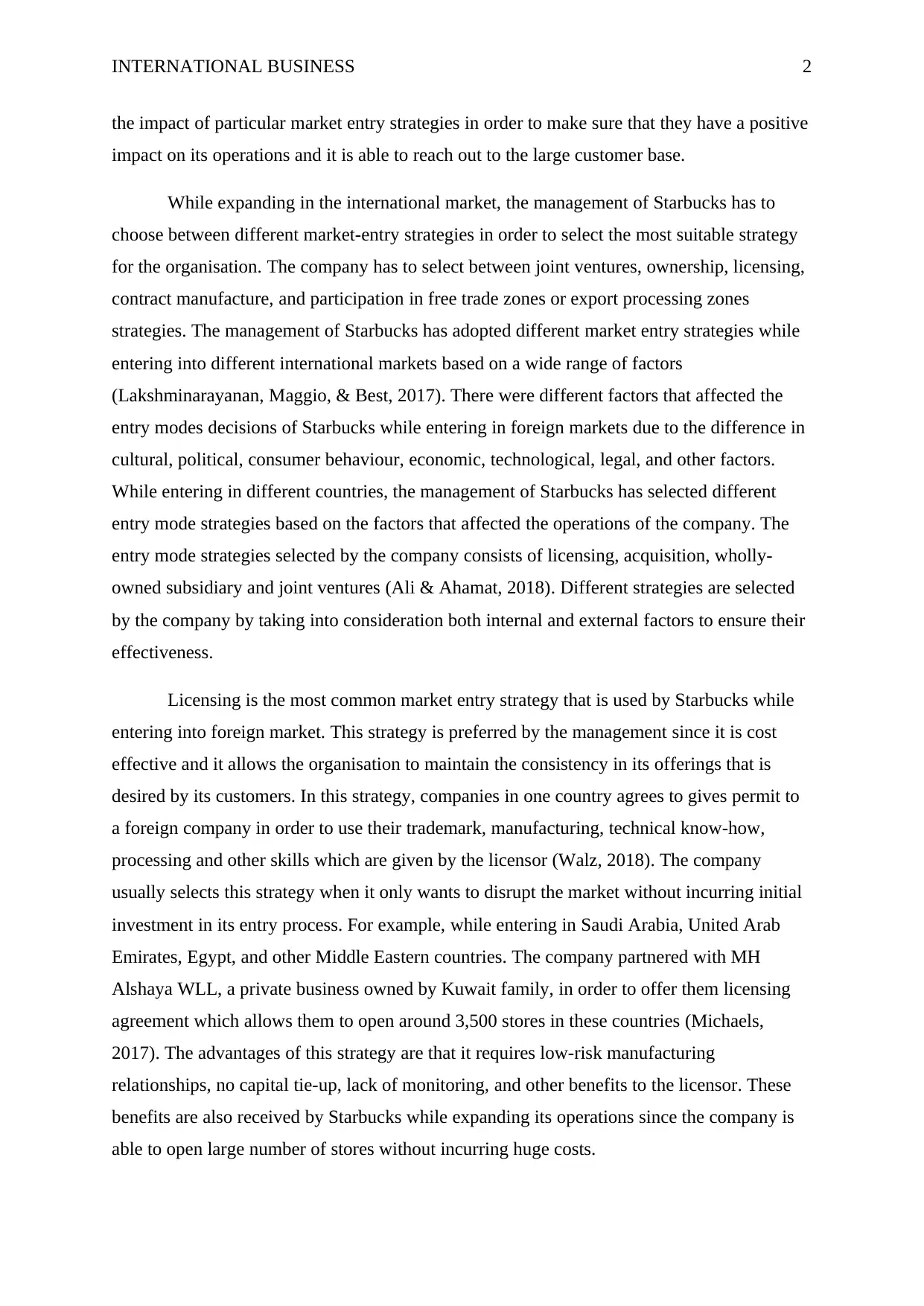
INTERNATIONAL BUSINESS 2
the impact of particular market entry strategies in order to make sure that they have a positive
impact on its operations and it is able to reach out to the large customer base.
While expanding in the international market, the management of Starbucks has to
choose between different market-entry strategies in order to select the most suitable strategy
for the organisation. The company has to select between joint ventures, ownership, licensing,
contract manufacture, and participation in free trade zones or export processing zones
strategies. The management of Starbucks has adopted different market entry strategies while
entering into different international markets based on a wide range of factors
(Lakshminarayanan, Maggio, & Best, 2017). There were different factors that affected the
entry modes decisions of Starbucks while entering in foreign markets due to the difference in
cultural, political, consumer behaviour, economic, technological, legal, and other factors.
While entering in different countries, the management of Starbucks has selected different
entry mode strategies based on the factors that affected the operations of the company. The
entry mode strategies selected by the company consists of licensing, acquisition, wholly-
owned subsidiary and joint ventures (Ali & Ahamat, 2018). Different strategies are selected
by the company by taking into consideration both internal and external factors to ensure their
effectiveness.
Licensing is the most common market entry strategy that is used by Starbucks while
entering into foreign market. This strategy is preferred by the management since it is cost
effective and it allows the organisation to maintain the consistency in its offerings that is
desired by its customers. In this strategy, companies in one country agrees to gives permit to
a foreign company in order to use their trademark, manufacturing, technical know-how,
processing and other skills which are given by the licensor (Walz, 2018). The company
usually selects this strategy when it only wants to disrupt the market without incurring initial
investment in its entry process. For example, while entering in Saudi Arabia, United Arab
Emirates, Egypt, and other Middle Eastern countries. The company partnered with MH
Alshaya WLL, a private business owned by Kuwait family, in order to offer them licensing
agreement which allows them to open around 3,500 stores in these countries (Michaels,
2017). The advantages of this strategy are that it requires low-risk manufacturing
relationships, no capital tie-up, lack of monitoring, and other benefits to the licensor. These
benefits are also received by Starbucks while expanding its operations since the company is
able to open large number of stores without incurring huge costs.
the impact of particular market entry strategies in order to make sure that they have a positive
impact on its operations and it is able to reach out to the large customer base.
While expanding in the international market, the management of Starbucks has to
choose between different market-entry strategies in order to select the most suitable strategy
for the organisation. The company has to select between joint ventures, ownership, licensing,
contract manufacture, and participation in free trade zones or export processing zones
strategies. The management of Starbucks has adopted different market entry strategies while
entering into different international markets based on a wide range of factors
(Lakshminarayanan, Maggio, & Best, 2017). There were different factors that affected the
entry modes decisions of Starbucks while entering in foreign markets due to the difference in
cultural, political, consumer behaviour, economic, technological, legal, and other factors.
While entering in different countries, the management of Starbucks has selected different
entry mode strategies based on the factors that affected the operations of the company. The
entry mode strategies selected by the company consists of licensing, acquisition, wholly-
owned subsidiary and joint ventures (Ali & Ahamat, 2018). Different strategies are selected
by the company by taking into consideration both internal and external factors to ensure their
effectiveness.
Licensing is the most common market entry strategy that is used by Starbucks while
entering into foreign market. This strategy is preferred by the management since it is cost
effective and it allows the organisation to maintain the consistency in its offerings that is
desired by its customers. In this strategy, companies in one country agrees to gives permit to
a foreign company in order to use their trademark, manufacturing, technical know-how,
processing and other skills which are given by the licensor (Walz, 2018). The company
usually selects this strategy when it only wants to disrupt the market without incurring initial
investment in its entry process. For example, while entering in Saudi Arabia, United Arab
Emirates, Egypt, and other Middle Eastern countries. The company partnered with MH
Alshaya WLL, a private business owned by Kuwait family, in order to offer them licensing
agreement which allows them to open around 3,500 stores in these countries (Michaels,
2017). The advantages of this strategy are that it requires low-risk manufacturing
relationships, no capital tie-up, lack of monitoring, and other benefits to the licensor. These
benefits are also received by Starbucks while expanding its operations since the company is
able to open large number of stores without incurring huge costs.
⊘ This is a preview!⊘
Do you want full access?
Subscribe today to unlock all pages.

Trusted by 1+ million students worldwide
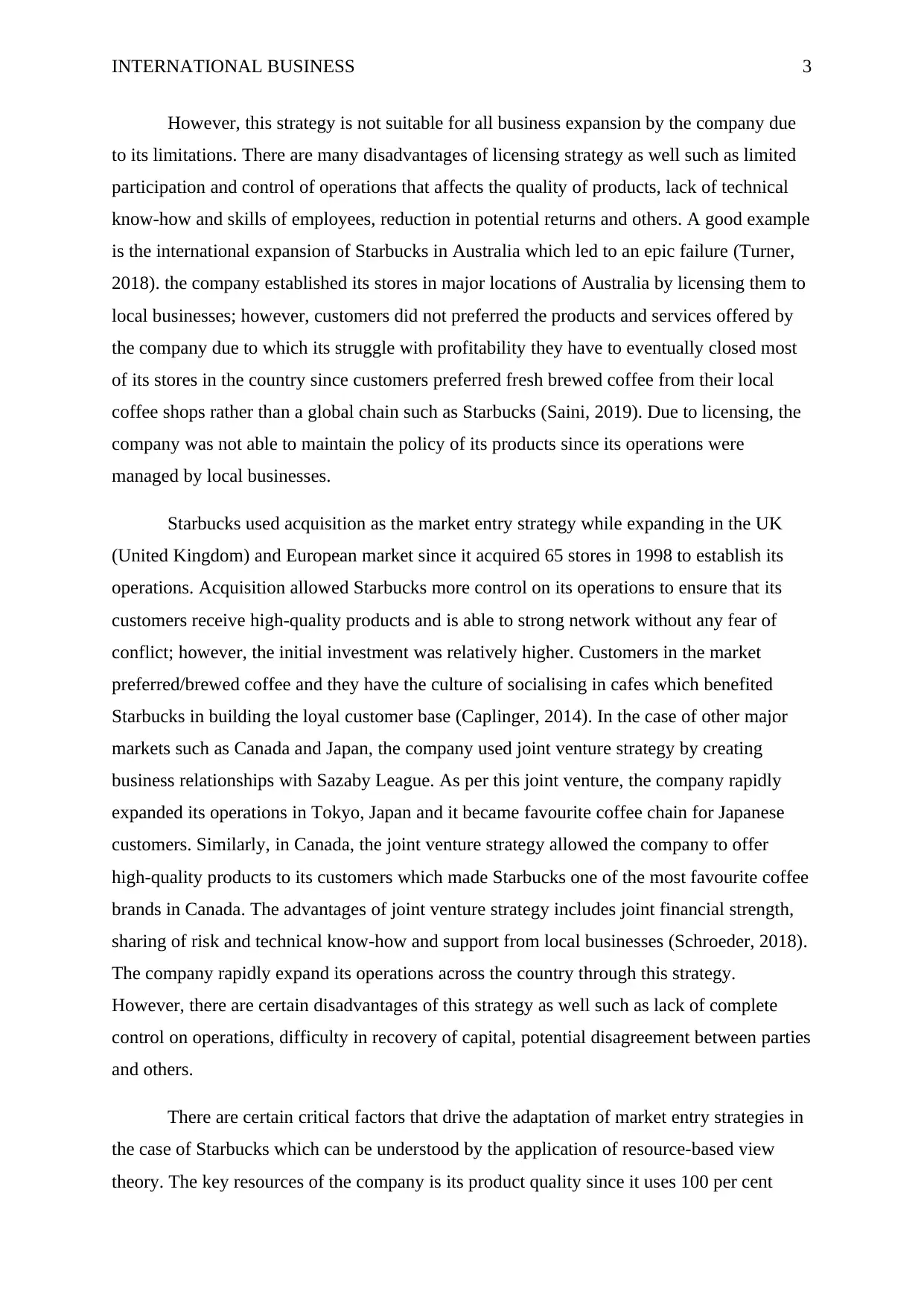
INTERNATIONAL BUSINESS 3
However, this strategy is not suitable for all business expansion by the company due
to its limitations. There are many disadvantages of licensing strategy as well such as limited
participation and control of operations that affects the quality of products, lack of technical
know-how and skills of employees, reduction in potential returns and others. A good example
is the international expansion of Starbucks in Australia which led to an epic failure (Turner,
2018). the company established its stores in major locations of Australia by licensing them to
local businesses; however, customers did not preferred the products and services offered by
the company due to which its struggle with profitability they have to eventually closed most
of its stores in the country since customers preferred fresh brewed coffee from their local
coffee shops rather than a global chain such as Starbucks (Saini, 2019). Due to licensing, the
company was not able to maintain the policy of its products since its operations were
managed by local businesses.
Starbucks used acquisition as the market entry strategy while expanding in the UK
(United Kingdom) and European market since it acquired 65 stores in 1998 to establish its
operations. Acquisition allowed Starbucks more control on its operations to ensure that its
customers receive high-quality products and is able to strong network without any fear of
conflict; however, the initial investment was relatively higher. Customers in the market
preferred/brewed coffee and they have the culture of socialising in cafes which benefited
Starbucks in building the loyal customer base (Caplinger, 2014). In the case of other major
markets such as Canada and Japan, the company used joint venture strategy by creating
business relationships with Sazaby League. As per this joint venture, the company rapidly
expanded its operations in Tokyo, Japan and it became favourite coffee chain for Japanese
customers. Similarly, in Canada, the joint venture strategy allowed the company to offer
high-quality products to its customers which made Starbucks one of the most favourite coffee
brands in Canada. The advantages of joint venture strategy includes joint financial strength,
sharing of risk and technical know-how and support from local businesses (Schroeder, 2018).
The company rapidly expand its operations across the country through this strategy.
However, there are certain disadvantages of this strategy as well such as lack of complete
control on operations, difficulty in recovery of capital, potential disagreement between parties
and others.
There are certain critical factors that drive the adaptation of market entry strategies in
the case of Starbucks which can be understood by the application of resource-based view
theory. The key resources of the company is its product quality since it uses 100 per cent
However, this strategy is not suitable for all business expansion by the company due
to its limitations. There are many disadvantages of licensing strategy as well such as limited
participation and control of operations that affects the quality of products, lack of technical
know-how and skills of employees, reduction in potential returns and others. A good example
is the international expansion of Starbucks in Australia which led to an epic failure (Turner,
2018). the company established its stores in major locations of Australia by licensing them to
local businesses; however, customers did not preferred the products and services offered by
the company due to which its struggle with profitability they have to eventually closed most
of its stores in the country since customers preferred fresh brewed coffee from their local
coffee shops rather than a global chain such as Starbucks (Saini, 2019). Due to licensing, the
company was not able to maintain the policy of its products since its operations were
managed by local businesses.
Starbucks used acquisition as the market entry strategy while expanding in the UK
(United Kingdom) and European market since it acquired 65 stores in 1998 to establish its
operations. Acquisition allowed Starbucks more control on its operations to ensure that its
customers receive high-quality products and is able to strong network without any fear of
conflict; however, the initial investment was relatively higher. Customers in the market
preferred/brewed coffee and they have the culture of socialising in cafes which benefited
Starbucks in building the loyal customer base (Caplinger, 2014). In the case of other major
markets such as Canada and Japan, the company used joint venture strategy by creating
business relationships with Sazaby League. As per this joint venture, the company rapidly
expanded its operations in Tokyo, Japan and it became favourite coffee chain for Japanese
customers. Similarly, in Canada, the joint venture strategy allowed the company to offer
high-quality products to its customers which made Starbucks one of the most favourite coffee
brands in Canada. The advantages of joint venture strategy includes joint financial strength,
sharing of risk and technical know-how and support from local businesses (Schroeder, 2018).
The company rapidly expand its operations across the country through this strategy.
However, there are certain disadvantages of this strategy as well such as lack of complete
control on operations, difficulty in recovery of capital, potential disagreement between parties
and others.
There are certain critical factors that drive the adaptation of market entry strategies in
the case of Starbucks which can be understood by the application of resource-based view
theory. The key resources of the company is its product quality since it uses 100 per cent
Paraphrase This Document
Need a fresh take? Get an instant paraphrase of this document with our AI Paraphraser

INTERNATIONAL BUSINESS 4
fresh and ethically sourced coffee beans and it also offers unique selection to its customers
ranging from Pumpkin Spice Latte to Frappuccino (Scott, 2019). As per the VRIO
framework, this resource is valuable since it drives the sales of the company. This is a rare
resource since it provides a unique brand reputation to the company that is different from its
competitors. This resource is inimitable because it requires high initial investment in the
supply chain process, strict control on operations, effective skills and knowledge of
employees. Lastly, this resource is organised since it allows the company to maintain
consistency in its product quality across 30,000 stores that are situated globally
(BusinessInsider, 2019). Another critical factor that drives adoption of these strategies is
consumer perception towards the brand. While entering in a foreign market, Starbucks
evaluates customers’ preferences to make necessary changes in its offerings that are catered
to their demands. Moreover, the majority of customers of Starbucks include millennials
whose demands are considered by the company while entering a new market, for example,
the study highlighted that 73 per cent millennials customers globally prefer to spend extra on
products that are sustainably sources (Curtin, 2018). Therefore, Starbucks makes sure that
100 per cent of its coffee beans are ethically sources and it also uses environmental friendly
methods to manage its operations while entering in a new market which provides it an edge
over its competitors and it led towards the effectiveness of market entry strategy (Velde,
2018).
The outcomes of these entry market strategies have been successful for the Starbucks.
For the most parts, these strategies have been successful for Starbucks allowing the
organisation to build a loyal customer baser on an international level (Rindova & Martins,
2018). Positive outcomes of these strategies include a high rate of profitability, growing
marketing share, increasing number of customers, positive brand reputation, global
distribution channels and others. In some areas, these strategies have failed such as the
example of failure of Starbucks in Australia; however, the management has learned from its
mistakes allowing them to capture new markets in developing countries such as India,
Taiwan and others (Jager, 2018). As per the resource-based view, the product quality offered
by the company is a key source of competitive advantage for Starbucks which is prioritized
by the company while selecting particular market entry strategies.
Although, the market entry strategies of Starbucks has been successful however the
company has seen many obstacles as well based on the following recommendations. While
moving forward, the management of Starbucks should thoroughly evaluate external aspects
fresh and ethically sourced coffee beans and it also offers unique selection to its customers
ranging from Pumpkin Spice Latte to Frappuccino (Scott, 2019). As per the VRIO
framework, this resource is valuable since it drives the sales of the company. This is a rare
resource since it provides a unique brand reputation to the company that is different from its
competitors. This resource is inimitable because it requires high initial investment in the
supply chain process, strict control on operations, effective skills and knowledge of
employees. Lastly, this resource is organised since it allows the company to maintain
consistency in its product quality across 30,000 stores that are situated globally
(BusinessInsider, 2019). Another critical factor that drives adoption of these strategies is
consumer perception towards the brand. While entering in a foreign market, Starbucks
evaluates customers’ preferences to make necessary changes in its offerings that are catered
to their demands. Moreover, the majority of customers of Starbucks include millennials
whose demands are considered by the company while entering a new market, for example,
the study highlighted that 73 per cent millennials customers globally prefer to spend extra on
products that are sustainably sources (Curtin, 2018). Therefore, Starbucks makes sure that
100 per cent of its coffee beans are ethically sources and it also uses environmental friendly
methods to manage its operations while entering in a new market which provides it an edge
over its competitors and it led towards the effectiveness of market entry strategy (Velde,
2018).
The outcomes of these entry market strategies have been successful for the Starbucks.
For the most parts, these strategies have been successful for Starbucks allowing the
organisation to build a loyal customer baser on an international level (Rindova & Martins,
2018). Positive outcomes of these strategies include a high rate of profitability, growing
marketing share, increasing number of customers, positive brand reputation, global
distribution channels and others. In some areas, these strategies have failed such as the
example of failure of Starbucks in Australia; however, the management has learned from its
mistakes allowing them to capture new markets in developing countries such as India,
Taiwan and others (Jager, 2018). As per the resource-based view, the product quality offered
by the company is a key source of competitive advantage for Starbucks which is prioritized
by the company while selecting particular market entry strategies.
Although, the market entry strategies of Starbucks has been successful however the
company has seen many obstacles as well based on the following recommendations. While
moving forward, the management of Starbucks should thoroughly evaluate external aspects
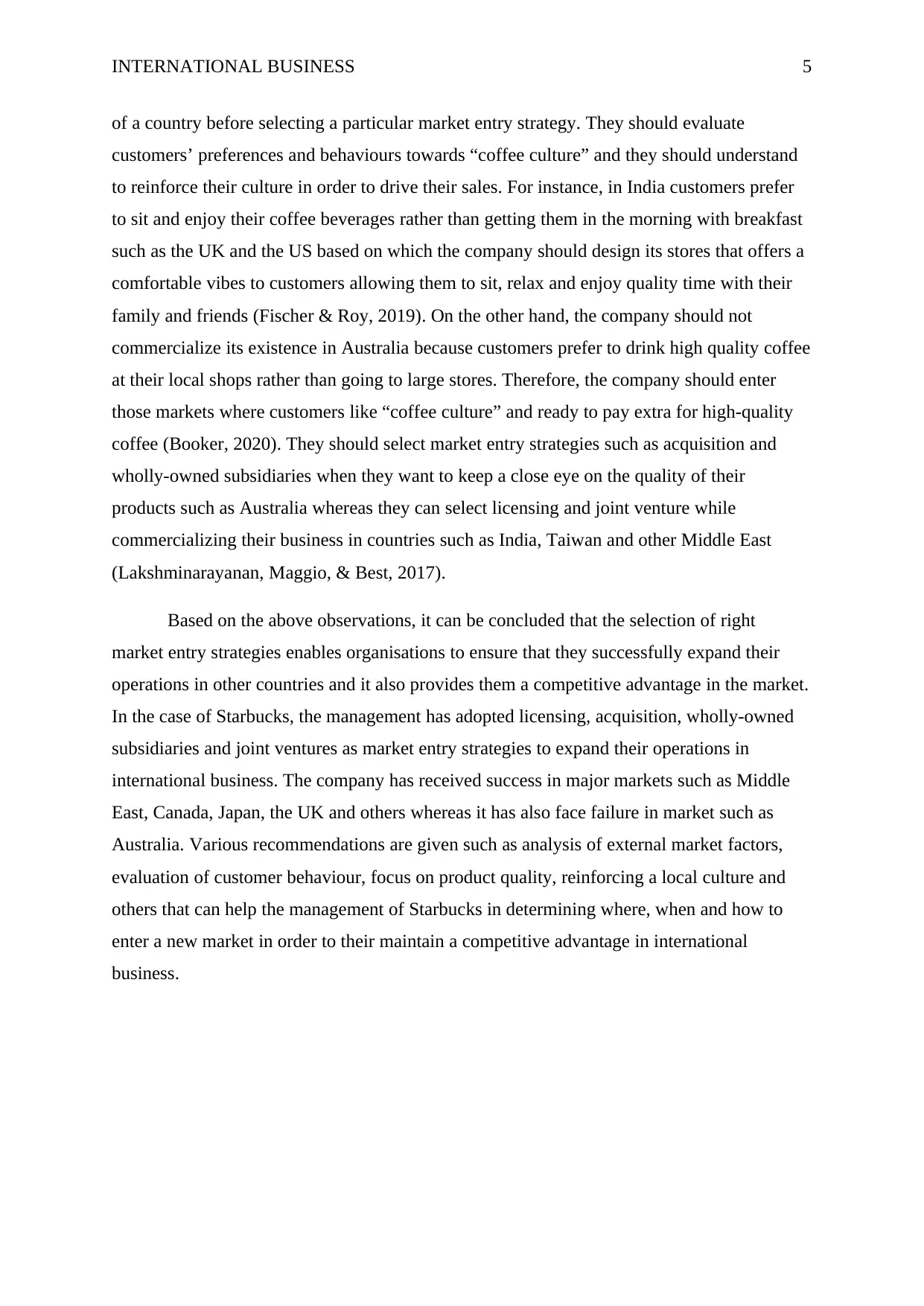
INTERNATIONAL BUSINESS 5
of a country before selecting a particular market entry strategy. They should evaluate
customers’ preferences and behaviours towards “coffee culture” and they should understand
to reinforce their culture in order to drive their sales. For instance, in India customers prefer
to sit and enjoy their coffee beverages rather than getting them in the morning with breakfast
such as the UK and the US based on which the company should design its stores that offers a
comfortable vibes to customers allowing them to sit, relax and enjoy quality time with their
family and friends (Fischer & Roy, 2019). On the other hand, the company should not
commercialize its existence in Australia because customers prefer to drink high quality coffee
at their local shops rather than going to large stores. Therefore, the company should enter
those markets where customers like “coffee culture” and ready to pay extra for high-quality
coffee (Booker, 2020). They should select market entry strategies such as acquisition and
wholly-owned subsidiaries when they want to keep a close eye on the quality of their
products such as Australia whereas they can select licensing and joint venture while
commercializing their business in countries such as India, Taiwan and other Middle East
(Lakshminarayanan, Maggio, & Best, 2017).
Based on the above observations, it can be concluded that the selection of right
market entry strategies enables organisations to ensure that they successfully expand their
operations in other countries and it also provides them a competitive advantage in the market.
In the case of Starbucks, the management has adopted licensing, acquisition, wholly-owned
subsidiaries and joint ventures as market entry strategies to expand their operations in
international business. The company has received success in major markets such as Middle
East, Canada, Japan, the UK and others whereas it has also face failure in market such as
Australia. Various recommendations are given such as analysis of external market factors,
evaluation of customer behaviour, focus on product quality, reinforcing a local culture and
others that can help the management of Starbucks in determining where, when and how to
enter a new market in order to their maintain a competitive advantage in international
business.
of a country before selecting a particular market entry strategy. They should evaluate
customers’ preferences and behaviours towards “coffee culture” and they should understand
to reinforce their culture in order to drive their sales. For instance, in India customers prefer
to sit and enjoy their coffee beverages rather than getting them in the morning with breakfast
such as the UK and the US based on which the company should design its stores that offers a
comfortable vibes to customers allowing them to sit, relax and enjoy quality time with their
family and friends (Fischer & Roy, 2019). On the other hand, the company should not
commercialize its existence in Australia because customers prefer to drink high quality coffee
at their local shops rather than going to large stores. Therefore, the company should enter
those markets where customers like “coffee culture” and ready to pay extra for high-quality
coffee (Booker, 2020). They should select market entry strategies such as acquisition and
wholly-owned subsidiaries when they want to keep a close eye on the quality of their
products such as Australia whereas they can select licensing and joint venture while
commercializing their business in countries such as India, Taiwan and other Middle East
(Lakshminarayanan, Maggio, & Best, 2017).
Based on the above observations, it can be concluded that the selection of right
market entry strategies enables organisations to ensure that they successfully expand their
operations in other countries and it also provides them a competitive advantage in the market.
In the case of Starbucks, the management has adopted licensing, acquisition, wholly-owned
subsidiaries and joint ventures as market entry strategies to expand their operations in
international business. The company has received success in major markets such as Middle
East, Canada, Japan, the UK and others whereas it has also face failure in market such as
Australia. Various recommendations are given such as analysis of external market factors,
evaluation of customer behaviour, focus on product quality, reinforcing a local culture and
others that can help the management of Starbucks in determining where, when and how to
enter a new market in order to their maintain a competitive advantage in international
business.
⊘ This is a preview!⊘
Do you want full access?
Subscribe today to unlock all pages.

Trusted by 1+ million students worldwide
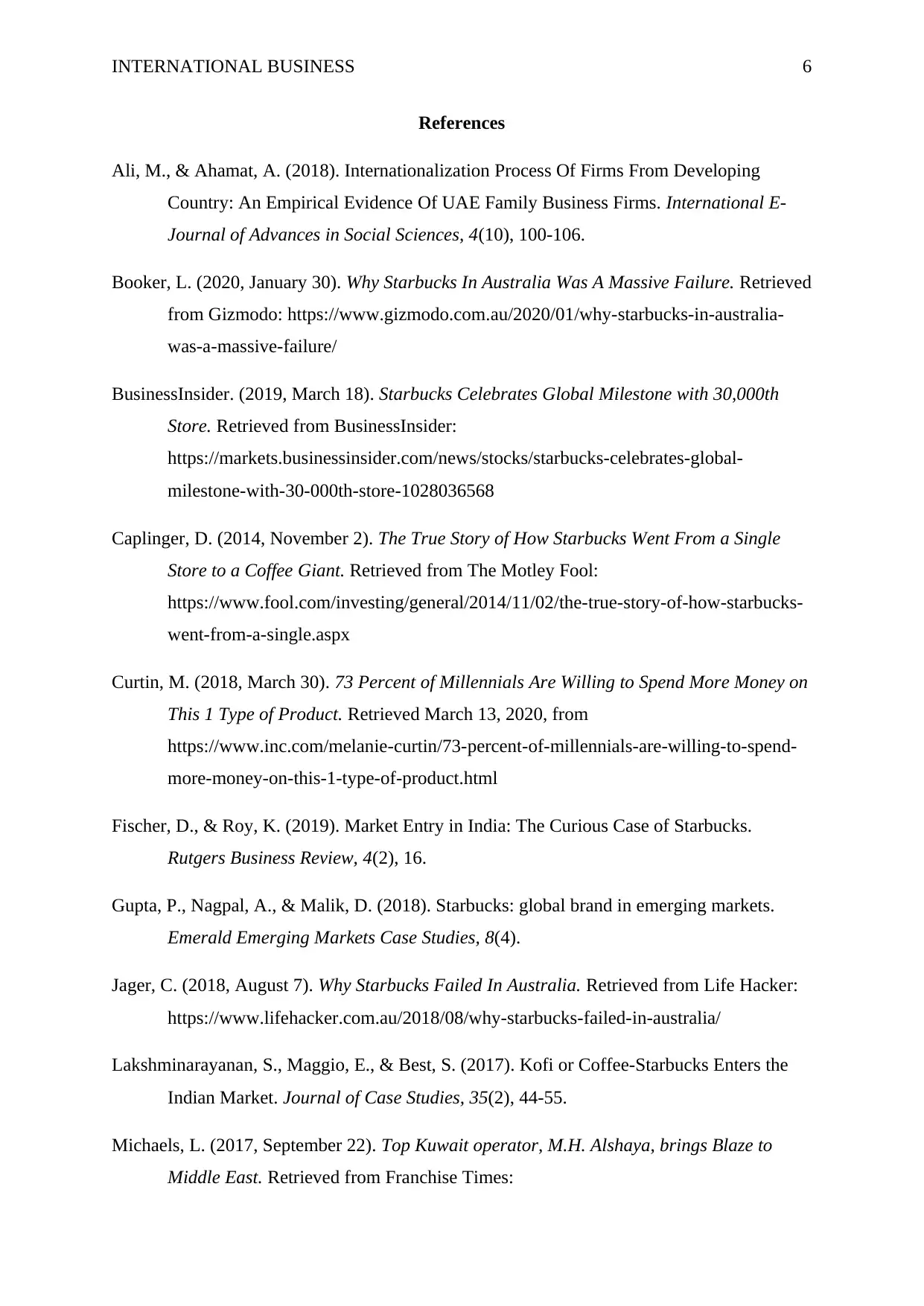
INTERNATIONAL BUSINESS 6
References
Ali, M., & Ahamat, A. (2018). Internationalization Process Of Firms From Developing
Country: An Empirical Evidence Of UAE Family Business Firms. International E-
Journal of Advances in Social Sciences, 4(10), 100-106.
Booker, L. (2020, January 30). Why Starbucks In Australia Was A Massive Failure. Retrieved
from Gizmodo: https://www.gizmodo.com.au/2020/01/why-starbucks-in-australia-
was-a-massive-failure/
BusinessInsider. (2019, March 18). Starbucks Celebrates Global Milestone with 30,000th
Store. Retrieved from BusinessInsider:
https://markets.businessinsider.com/news/stocks/starbucks-celebrates-global-
milestone-with-30-000th-store-1028036568
Caplinger, D. (2014, November 2). The True Story of How Starbucks Went From a Single
Store to a Coffee Giant. Retrieved from The Motley Fool:
https://www.fool.com/investing/general/2014/11/02/the-true-story-of-how-starbucks-
went-from-a-single.aspx
Curtin, M. (2018, March 30). 73 Percent of Millennials Are Willing to Spend More Money on
This 1 Type of Product. Retrieved March 13, 2020, from
https://www.inc.com/melanie-curtin/73-percent-of-millennials-are-willing-to-spend-
more-money-on-this-1-type-of-product.html
Fischer, D., & Roy, K. (2019). Market Entry in India: The Curious Case of Starbucks.
Rutgers Business Review, 4(2), 16.
Gupta, P., Nagpal, A., & Malik, D. (2018). Starbucks: global brand in emerging markets.
Emerald Emerging Markets Case Studies, 8(4).
Jager, C. (2018, August 7). Why Starbucks Failed In Australia. Retrieved from Life Hacker:
https://www.lifehacker.com.au/2018/08/why-starbucks-failed-in-australia/
Lakshminarayanan, S., Maggio, E., & Best, S. (2017). Kofi or Coffee-Starbucks Enters the
Indian Market. Journal of Case Studies, 35(2), 44-55.
Michaels, L. (2017, September 22). Top Kuwait operator, M.H. Alshaya, brings Blaze to
Middle East. Retrieved from Franchise Times:
References
Ali, M., & Ahamat, A. (2018). Internationalization Process Of Firms From Developing
Country: An Empirical Evidence Of UAE Family Business Firms. International E-
Journal of Advances in Social Sciences, 4(10), 100-106.
Booker, L. (2020, January 30). Why Starbucks In Australia Was A Massive Failure. Retrieved
from Gizmodo: https://www.gizmodo.com.au/2020/01/why-starbucks-in-australia-
was-a-massive-failure/
BusinessInsider. (2019, March 18). Starbucks Celebrates Global Milestone with 30,000th
Store. Retrieved from BusinessInsider:
https://markets.businessinsider.com/news/stocks/starbucks-celebrates-global-
milestone-with-30-000th-store-1028036568
Caplinger, D. (2014, November 2). The True Story of How Starbucks Went From a Single
Store to a Coffee Giant. Retrieved from The Motley Fool:
https://www.fool.com/investing/general/2014/11/02/the-true-story-of-how-starbucks-
went-from-a-single.aspx
Curtin, M. (2018, March 30). 73 Percent of Millennials Are Willing to Spend More Money on
This 1 Type of Product. Retrieved March 13, 2020, from
https://www.inc.com/melanie-curtin/73-percent-of-millennials-are-willing-to-spend-
more-money-on-this-1-type-of-product.html
Fischer, D., & Roy, K. (2019). Market Entry in India: The Curious Case of Starbucks.
Rutgers Business Review, 4(2), 16.
Gupta, P., Nagpal, A., & Malik, D. (2018). Starbucks: global brand in emerging markets.
Emerald Emerging Markets Case Studies, 8(4).
Jager, C. (2018, August 7). Why Starbucks Failed In Australia. Retrieved from Life Hacker:
https://www.lifehacker.com.au/2018/08/why-starbucks-failed-in-australia/
Lakshminarayanan, S., Maggio, E., & Best, S. (2017). Kofi or Coffee-Starbucks Enters the
Indian Market. Journal of Case Studies, 35(2), 44-55.
Michaels, L. (2017, September 22). Top Kuwait operator, M.H. Alshaya, brings Blaze to
Middle East. Retrieved from Franchise Times:
Paraphrase This Document
Need a fresh take? Get an instant paraphrase of this document with our AI Paraphraser
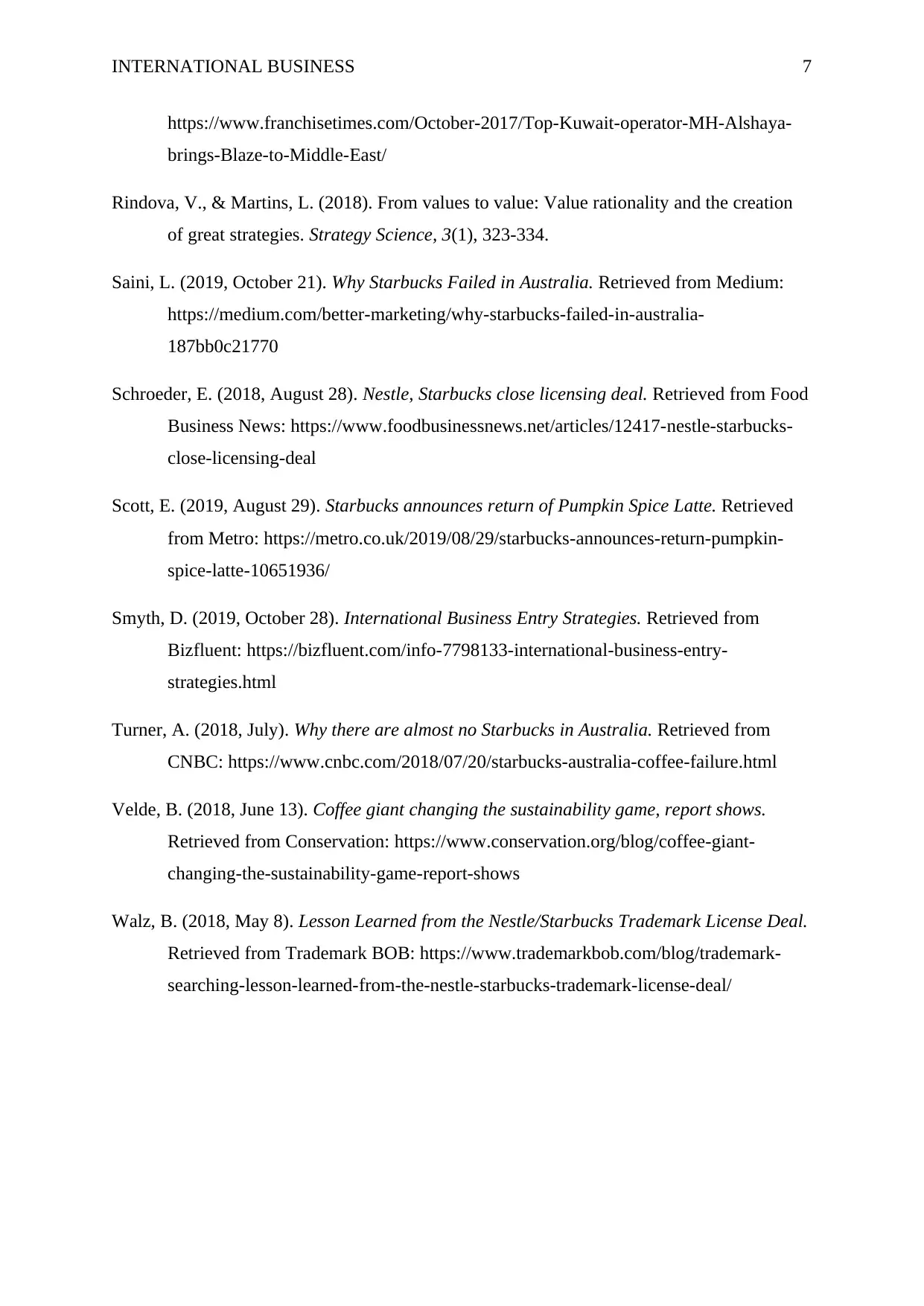
INTERNATIONAL BUSINESS 7
https://www.franchisetimes.com/October-2017/Top-Kuwait-operator-MH-Alshaya-
brings-Blaze-to-Middle-East/
Rindova, V., & Martins, L. (2018). From values to value: Value rationality and the creation
of great strategies. Strategy Science, 3(1), 323-334.
Saini, L. (2019, October 21). Why Starbucks Failed in Australia. Retrieved from Medium:
https://medium.com/better-marketing/why-starbucks-failed-in-australia-
187bb0c21770
Schroeder, E. (2018, August 28). Nestle, Starbucks close licensing deal. Retrieved from Food
Business News: https://www.foodbusinessnews.net/articles/12417-nestle-starbucks-
close-licensing-deal
Scott, E. (2019, August 29). Starbucks announces return of Pumpkin Spice Latte. Retrieved
from Metro: https://metro.co.uk/2019/08/29/starbucks-announces-return-pumpkin-
spice-latte-10651936/
Smyth, D. (2019, October 28). International Business Entry Strategies. Retrieved from
Bizfluent: https://bizfluent.com/info-7798133-international-business-entry-
strategies.html
Turner, A. (2018, July). Why there are almost no Starbucks in Australia. Retrieved from
CNBC: https://www.cnbc.com/2018/07/20/starbucks-australia-coffee-failure.html
Velde, B. (2018, June 13). Coffee giant changing the sustainability game, report shows.
Retrieved from Conservation: https://www.conservation.org/blog/coffee-giant-
changing-the-sustainability-game-report-shows
Walz, B. (2018, May 8). Lesson Learned from the Nestle/Starbucks Trademark License Deal.
Retrieved from Trademark BOB: https://www.trademarkbob.com/blog/trademark-
searching-lesson-learned-from-the-nestle-starbucks-trademark-license-deal/
https://www.franchisetimes.com/October-2017/Top-Kuwait-operator-MH-Alshaya-
brings-Blaze-to-Middle-East/
Rindova, V., & Martins, L. (2018). From values to value: Value rationality and the creation
of great strategies. Strategy Science, 3(1), 323-334.
Saini, L. (2019, October 21). Why Starbucks Failed in Australia. Retrieved from Medium:
https://medium.com/better-marketing/why-starbucks-failed-in-australia-
187bb0c21770
Schroeder, E. (2018, August 28). Nestle, Starbucks close licensing deal. Retrieved from Food
Business News: https://www.foodbusinessnews.net/articles/12417-nestle-starbucks-
close-licensing-deal
Scott, E. (2019, August 29). Starbucks announces return of Pumpkin Spice Latte. Retrieved
from Metro: https://metro.co.uk/2019/08/29/starbucks-announces-return-pumpkin-
spice-latte-10651936/
Smyth, D. (2019, October 28). International Business Entry Strategies. Retrieved from
Bizfluent: https://bizfluent.com/info-7798133-international-business-entry-
strategies.html
Turner, A. (2018, July). Why there are almost no Starbucks in Australia. Retrieved from
CNBC: https://www.cnbc.com/2018/07/20/starbucks-australia-coffee-failure.html
Velde, B. (2018, June 13). Coffee giant changing the sustainability game, report shows.
Retrieved from Conservation: https://www.conservation.org/blog/coffee-giant-
changing-the-sustainability-game-report-shows
Walz, B. (2018, May 8). Lesson Learned from the Nestle/Starbucks Trademark License Deal.
Retrieved from Trademark BOB: https://www.trademarkbob.com/blog/trademark-
searching-lesson-learned-from-the-nestle-starbucks-trademark-license-deal/
1 out of 8
Related Documents
Your All-in-One AI-Powered Toolkit for Academic Success.
+13062052269
info@desklib.com
Available 24*7 on WhatsApp / Email
![[object Object]](/_next/static/media/star-bottom.7253800d.svg)
Unlock your academic potential
Copyright © 2020–2025 A2Z Services. All Rights Reserved. Developed and managed by ZUCOL.





